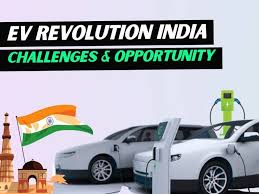🚗 Introduction
Electric Vehicles (EVs) are no longer a futuristic dream in India—they are becoming a key part of the country’s mobility revolution. With government incentives, growing environmental awareness, and improving tech, the Indian EV market is accelerating rapidly. But the road ahead has both bright opportunities and significant challenges.
Let’s explore the current landscape and what’s driving this electric transformation.
🔋 Current EV Market Overview in India
- India aims to have 30% of new vehicle sales as electric by 2030.
- In 2024, EV sales crossed 800,000 units, a 45% year-on-year growth.
- Two-wheelers and three-wheelers dominate EV sales; passenger cars and buses are growing steadily.
- Key players: Tata Motors, Ather Energy, Ola Electric, Hero Electric, Mahindra Electric.
🚦 Government Policies Driving EV Growth
- Faster Adoption and Manufacturing of Hybrid & Electric Vehicles (FAME-II) scheme offers subsidies and incentives.
- Reduced GST on EVs (from 12% to 5%).
- State-level policies supporting EV infrastructure and manufacturing hubs (e.g., Maharashtra, Karnataka, Tamil Nadu).
- Plans to set up 2,700+ public charging stations nationwide by 2025.
🌟 Opportunities in the EV Sector
1. Growing Consumer Interest
- Rising fuel prices and pollution concerns are shifting preferences.
- Improved vehicle range and charging infrastructure build confidence.
2. Make in India Push
- Domestic manufacturing of batteries, motors, and vehicles creates jobs.
- Battery Recycling and Second Life Battery industries are emerging.
3. Technological Innovation
- Advances in lithium-ion batteries, solid-state batteries, and fast charging.
- Startups working on battery swapping, AI-powered fleet management.
4. Export Potential
- India aims to export EV components and vehicles to global markets.
⚠️ Challenges to Overcome
| Challenge | Description |
|---|---|
| 🚧 Charging Infrastructure | Insufficient public chargers, especially in rural areas |
| 🔋 Battery Costs | High cost of lithium-ion batteries raises vehicle prices |
| ⚙️ Supply Chain Dependence | Heavy reliance on imports for raw materials like lithium, cobalt |
| 🛠️ Skilled Workforce | Need for trained technicians and engineers for EV servicing |
| 📜 Regulatory Hurdles | Fragmented policies across states, unclear standards |
🌱 Industry & Market Outlook
- Major automakers plan to launch 50+ EV models by 2027.
- Battery prices expected to drop 40% by 2030, making EVs more affordable.
- Electric public transport and last-mile delivery vehicles will see rapid adoption.
- India’s EV market could reach $80 billion by 2030.
🧠 Expert Insight
“India’s EV story is not just about vehicles—it’s about building an entire ecosystem of sustainable energy, manufacturing, and innovation.”
— Dr. Ritu Singh, EV Industry Analyst
🔚 Conclusion
The rise of electric vehicles in India is a game-changer for the environment, economy, and consumers. While there are hurdles in infrastructure and supply chains, the government, industry, and startups are collaborating like never before to accelerate the EV revolution.
For investors, consumers, and policymakers alike, the EV sector offers tremendous potential—but success depends on addressing challenges proactively.
































































